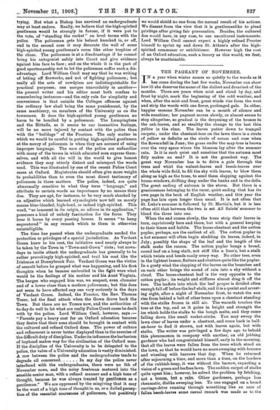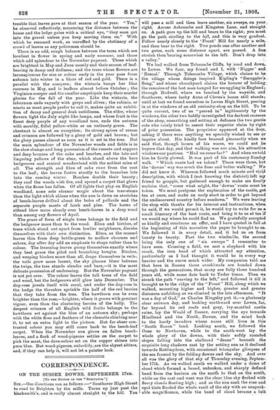THE PAGEANT OF NOVEMBER.
IN a year when winter comes so quietly to the woods as it has come during the last few weeks, November can show how ill she deserves the name of the dullest and dreariest of the months. There are years when mist and cloud by day, and frost by night, mark the beginning of the cold weather, and when, after the mist and frost, great winds rise from the west and strip the woods with one fierce, prolonged gale. In other, happier seasons November can be a month of silence and wide sunshine; her pageant moves slowly, or almost seems to stop altogether, so gradual is the deepening of the bronze in the oak-leaves, and so stealthy the change to the last thin yellow in the elms. The leaves patter down to tranquil carpets ; under the chestnut-tree on the lawn there is a circle of yellow as definite as the circle of cream and rose when the flowers fell in June; the grass under the may-tree is brown over the very space where the blossom lay after the summer rain. Is it in such quiet and sunshine that the autumn most fitly makes an end ? It is not the grandest way. The great way November has is to drive a gale through the trees and whirl the walnut-leaves and beech-leaves over the whole wide field, to fill the sky with leaves, to blow them along as high as the trees, to send them slapping against the house-windows, drifting deep under the banks and in the dells. The great ending of autumn is the storm. But there is a graciousness belonging to the rarer, quiet ending that has its own page in the book of English weather, and this year the page has lain open longer than usual. It is not often that St. Luke's summer is followed by St. Martin's, but it is less often still that between the two is set All Saints' summer to blend the three into one.
When the end comes slowly, the trees strip their leaves in turn, capriciously here and there, but with a general keeping to their times and habits. The horse-chestnut and the cotton poplar, perhaps, are the earliest of all. The cotton poplar in a hot summer will often begin shedding its leaves, indeed, in July; possibly the shape of the leaf and the length of the stalk make the reason. The cotton poplar bangs a broad, round leaf on a long stalk, not stiff like a lime's, but a stalk which twists and bends easily every way. No other tree, even in the lightest breeze, flutters and chatters quite like the poplar. In a gusty wind the slapping of the leaves on the branches and on each other brings the sound of rain into a sky without a cloud. The horse-chestnut leaf is the very opposite to the cotton poplar ; its weight and stiffness almost drag it off the tree. The leaflets into which the leaf proper is divided often enough fall off before the leaf-stalk, and it is a quaint and arrest- ing sight, after a night of November frost, to watch the sun
rise from behind a belt of other trees upon a chestnut standing with the stalks frozen in still air. The warmth touches the tree at the top, and as it gains in height and strength the ice which holds the stalks to the bough melts, and they come falling down like small rocket-sticks. You may sweep the lawn clear of leaves under a chestnut, and come back in half- an-hour to find it strewn, not with leaves again, but with stalks. The writer was privileged a few days ago to behold this phenomenon in company with another, an old jobbing gardener who had congratulated himself, early in the morning, that all the leaves were fallen from the trees which stood on
the lawn, so that he would have no more sweeping with brooms and wheeling with barrows that day. When be returned after sojourning a time, and more than a time, on the borders of the rubbish-heap, it was without the barrow, expecting a vision of a green and leafless lawn. The sudden carpet of stalks quite upset him; however, he solved the problem by fetching, not a broom, but a rake. Other gardeners, perhaps less rheumatic, dislike sweeping less. To one engaged on a broad carriage-drive running through something like an acre of fallen beech-leaves some casual remark was made as to the
trouble that leaves gave at that season of the year. "Yes," he observed reflectively, measuring the distance between the house and the lodge gates with a critical eye, "they soon get into the gravel unless you keep moving them on." With which he resumed work, as unruffled by the obstinacy of a crowd of leaves as any policeman should be.
There is an odd, rough balance between the trees which are loveliest in flower in spring and early summer, and those -which add splendour to the November pageant. Those which are brightest in May and June mostly end their season of leaf. bearing in damp and dullness; and the trees whose flowers are inconspicuous for size or colour early in the year pass from autumn into winter in a blaze of red and gold. There is a parallel with the creepers ; the wistaria hangs her lilac racemes in May, and is leafless almost before October ; the Virginian creeper and the smaller ampelopsis keep their scarlet glories for the fall of the year. Like the wistaria, the laburnum ends vaguely with greys and olives ; the robinia, or acacia as most people prefer to call it, makes quite an exhibi- tion of decay and general drab untidiness. The elder, whose flowers light the July night like lamps, and whose fruit is the finest deep purple of any woodland tree, ends the autumn with mouldy, fitful yellow-white or an untimely green. The chestnut is almost an exception; its strong spires of cream and crimson are followed by a glory of gold and brown; but the glory passes almost as soon as it is set in the tree. But the main splendour of the November woods and fields is in the slow change and long possession of the russets and coppers and deep bronzes of the oaks and beeches, and the late and lingering yellows of the elms, which stand above the bare hedgerows and central meadowland with the noblest mien of all. The strength and fibre of oaks runs from the root to the leaf ; the leaves fasten stoutly to the branches late into the coming winter. Beeches double their beauty ; they roof the woods with fire, and spread a carpet that glows when the flame has fallen. Of all lights that play on English woodland, none sets cleaner magic about the tree-stems than the light which shines when the sun is down on stretches of beech-leaves drifted about the boles of pollards and the separate .purple masts of larch and pine. The horns of eltland blow mcre clearly over beech-leaves in a deep wood than among any flowers of April.
The grace of form of single trees belongs to the field and the hedgerow more than to the wood. Elms and birches, of trees which stand out apart from lowlier neighbours, disrobe themselves with their own distinction. Elms, as the massed leaves thin from deep bottle-green to mellow chromes and ochres, day after day add an emphasis to shape rather than to colour. The lessening leaves group themselves exactly where they-best grace the piled and branching boughs. Birches, and weeping birches more than all, drape themselves in veils; the veils grow more lucent, the sky gleams bluer between the twigs, the tree stands slender and bare,—it is the most delicate procession of undressing. But the November pageant is not yet over. The colour leaves the tall trees of the field and wood, but the hedgerows still glow into December. The dog-rose jewels itself with coral, and under the dog-rose in the hedge the thrushes sprinkle the half of the red berries that they take from the tree. The hawthorn can be even brighter than the rose,—brighter, where it grows with greatest vigour, even than the clustering berries of the holly. The deepest crimson of all English wild fruits belongs to the hawthorn set against the blue of an autumn sky; perhaps with the white floss and feathers of the clematis climbing near it, to set an extra light in the picture. But for sheer con- trasted colour you may still come back to the beech-leaf carpet. When the November sun glows on fallen beech- leaves, and a flock of wood-pigeons settles on the carpet to pick the mast, the dove-colour set on the copper shines into pure blue. But wood-pigeons, unluckily, are the shyest sitters, and, if they can help it, will not let a painter look.

































































 Previous page
Previous page